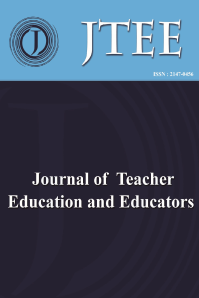OTMG Modelinin Okul Kültürüne Etkisi (Hatay İli Örneği
Eğitim alanında bir mesleki gelişim modeli olan Okul Temelli Mesleki Gelişim (OTMG) Modeli, mesleki yeterliklerini geliştirmek isteyen öğretmene, kendi gelişim ihtiyacını ve bunu karşılama yöntemini kendisinin belirlemesi, hazırladığı mesleki gelişim planını uygulaması ve izlemesi süreçlerinde yol haritası sunması bakımından hizmet içi eğitim sisteminde yeni bir kavramdır. Bu araştırmanın amacı, öğretmenlik mesleği genel yeterliklerine dayalı olarak geliştirilen ve orta öğretim kurumlarında pilot uygulaması gerçekleştirilen yönetici ve öğretmenlerin görüşlerine dayalı olarak OTMG Modeli’nin, Hatay ilinde okul kültürüne etkisini değerlendirmektir. Bu amaç doğrultusunda aynı sorulardan oluşan program öncesi ve program sonrası olarak adlandırılan anketler geliştirilerek Hatay ili, OTMG pilot uygulaması için seçilen dört orta öğretim okulunda (Fen Lisesinden 19, Anadolu Öğretmen Lisesinden 17, Anadolu Lisesinden 23 ve Genel Liseden 39 kişi olmak üzere) 98 yönetici ve öğretmene uygulanmış ve değerlendirmeler yapılmıştır. Gerçekleştirilen bu araştırmada karma desen benimsenmiştir. Bu doğrultuda taramada birçok açık uçlu, yarı yapılandırılmış ve derecelendirilmiş (5’li) maddeler içeren bir anket uygulanmış ve modelin okul kültürüne etkisi araştırılmıştır
Anahtar Kelimeler:
Okul Temelli Mesleki Gelişim, Mesleki Gelişim
The Effect of the OTMG Model on School Culture (Example of Hatay City)
The Model of School Based Professional Development (OTMG) is a new concept of professional development in the in-service training system aimed at providing a road map for meeting teachers’ development needs and preparing their methods of identification, implementation and monitoring of the plan by the process of professional development for teachers who want to develop their professional competences. The overall objective of this study was to evaluate the effectiveness of individual and professional development on the OTMG Model’s pilot application, on the basis of their proficiency in the teaching profession, and on the basis of the views of teachers and administrators in secondary schools. For this purpose, pre-and post-program surveys were applied, consisting of the same questions to 98 managers and teachers in the four secondary schools (Science High School 19, Anatolian Teacher High School 17, Anatolian High School 23 and General High School, 39 people) which were selected for the pilot implementation of the model in Hatay. In this research both qualitative and quantitative methods together were adopted. So a screening questionnaire containing open-ended questions, semi-structured questions and degreed questions (5 degrees) was applied in the survey
___
- Linn, J.A. (2003). Active or avoidant: Two methods of resisting persuasion. (Unpublished doctoral dissertation).University ofArkansas,Fayetteville.
- Ekinci, C. E. (1999). Hacettepe ve erciyes üniversiteleri öğrencilerinin yükseköğretimin finansmanına ilişkin görüşlerinin öğrencilerin sosyoekonomik özellikleri temelinde değerlendirilmesi (Yayımlanmamış doktora tezi). Hacettepe Üniversitesi, Ankara.
- Kavak, Y. (2011). Türkiye’de yükseköğretimde büyüme: yakın geçmişe bakış ve uzun vadeli (2010-50) büyüme projeksiyonları. Çalışma uluslararası yükseköğretim kongresinde sözlü bildiri olarak sunulmuştur. İstanbul, Türkiye, 27-29 Mayıs.
- Laksmana, C. M. (2010). Understanding women education with reference to professional and higher education in ındia’. Paper presented at the international conference on women education for empowerment organized by the ımmaculate college of women for education, Puduchery, Tamil Nadu, India, 5th to 6th February
- Goddard, R.D. & Goddard, Y.L. (2001). A Multilevel Analysis of TheRelationship Between Teacher and Collective Efficacy in Urban Schools. Teaching and Teacher Education, 17, 807–818, Retrieved from www.elseiver.com/locate/tate. 12.10.2009
- TBMM, (2011). http://www.tbmm.gov.tr/anayasa/anayasa24.htm, adresinden 01.08. 2011 tarihinde indirilmiştir
- ISSN: 2147-0456
- Başlangıç: 2012
- Yayıncı: İlknur GÖKÇE
Sayıdaki Diğer Makaleler
OTMG Modelinin Okul Kültürüne Etkisi (Hatay İli Örneği
